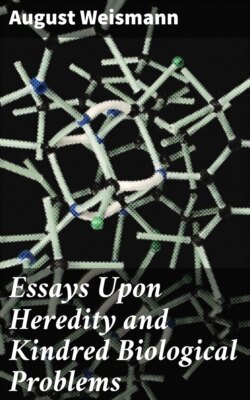Читать книгу Essays Upon Heredity and Kindred Biological Problems - Weismann August - Страница 10
На сайте Литреса книга снята с продажи.
Note 6. Unequal Length of Life in the two Sexes.
ОглавлениеTable of Contents
This inequality is frequently found among insects. The males of the remarkable little parasites infesting bees, the Strepsiptera, only live for two to three hours in the mature condition, while the wingless, maggot-like, female lives eight days: in this case, therefore, the female lives sixty-four times as long as the male. The explanation of these relations is obvious; a long life for the male would be useless to the species, while the relatively long life of the female is a necessity for the species, inasmuch as she is viviparous, and must nourish her young until their birth.
Again, the male of Phylloxera vastatrix lives for a much shorter period than the female, and is devoid of proboscis and stomach, and takes no food: it fertilizes the female as soon as the last skin has been shed and then dies.
Insects are not the only animals among which we find inequality in the length of life of the two sexes. Very little attention has been hitherto directed to this matter, and we therefore possess little or no accurate information as to the duration of life in the sexes, but in some cases we can draw inferences either from anatomical structure or from the mode of development. Thus, male Rotifers never possess mouth, stomach, or intestine, they cannot take food, and without doubt live much shorter lives than the females, which are provided with a complete alimentary canal. Again, the dwarf males of many parasitic Copepods—low Crustacea—and the ‘complementary males’ of Cirrhipedes (or barnacles) are devoid of stomach, and must live for a much shorter time than the females; and the male Entoniscidae (a family of which the species are endo-parasitic in the larger Crustacea), although they can feed, die after fertilizing the females; while the latter then take to a parasitic life, produce eggs, and continue to live for some time. It is supposed that the dwarf male of Bonellia viridis does not live so long by several years as the hundred times larger female, and it too has no mouth to its alimentary canal. These examples might be further increased by reference to zoological literature.
In most cases the female lives longer than the male, and this needs no special explanation; but the converse relation is conceivable, when, for instance, the females are much rarer than the males, and the latter lose much time in seeking them. The above-mentioned case of Aglia tau probably belongs to this category.
We cannot always decide conclusively whether the life of one sex has been lengthened or that of the other shortened; both these changes must have taken place in different cases. There is no doubt that a lengthening of life in the female has arisen in the bees and ants, for both sexes of the saw-flies, which are believed to be the ancestors of bees, only live for a few weeks. But among the Strepsiptera the shorter life of the male must have been secondarily acquired, since we only rarely meet with such an extreme case in insects.
